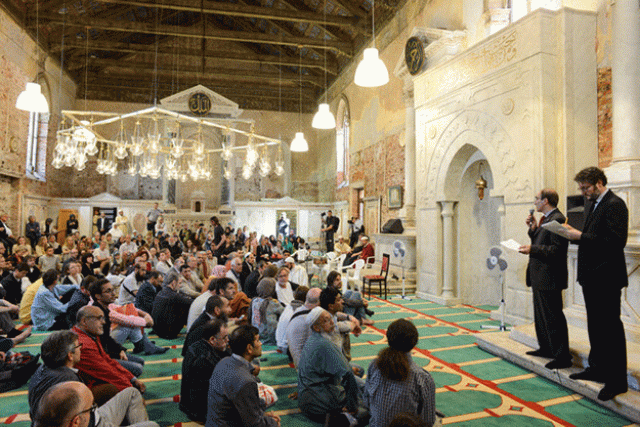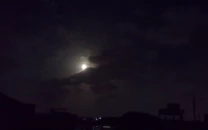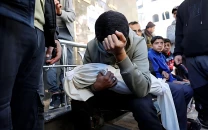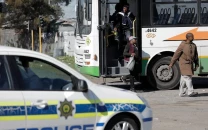Police shut down mosque installation at Venice church
Made inside a Catholic church, the project served as Iceland's national pavilion for the 56th Venice Biennale

PHOTO: THE NEW YORK TIMES
Officials said the artist of the exhibit, Christoph Büchel, had not obtained proper permits and violated laws by allowing too many people inside the mosque to worship.
The Santa Maria della Misericordia church in Venice, which closed to worshippers 40 years ago, had been transformed into a mosque as part of the Venice Biennale — the world’s most prestigious contemporary art exhibit.
Read: Venice church transforms into mosque for seven months
“The Mosque” was designed by Büchel as Iceland’s entry to the art exhibition. The exhibit sought to challenge attitudes towards Islam and was to be the only mosque in Venice’s city centre for seven months.
The art and architecture of Venice is said to be deeply influenced by Islamic trade and culture. As immigration from Islamic countries to Europe increases, the issue of the installation became central to debates regarding Muslim worship and culture across Europe.
Venetian city officials and police authorities were reportedly upset by the installation prior to its opening on May 8, who warned that it posed a security threat because of possible violence either by anti-Islamic extremists or Islamic extremists upset that a mosque was created inside a church.
Catholic church officials also became involved in the dispute, contending that the church, Santa Maria della Misericordia, in the Cannaregio neighborhood, had never been officially deconsecrated — despite being mostly closed for more than 40 years — and so it was improper to use it for purposes other than Catholic worship.
Hundreds of Muslim residents of Venice and surrounding areas have come to see and worship at the mosque since its opening.
"The police came after 11 this morning and requested that we close it,” said Büchel in a Skype interview.
Read: French Muslim leader calls for doubling of mosques
"My site manager told me that they deposited a three or four-page document saying that there were violations and that it’s not approved for occupation anymore," he added.

PHOTO: THE NEW YORK TIMES
"He said he intended to pursue all legal remedies to fight the closing and hoped to reopen The Mosque. Until there is a resolution, we cannot have the doors open."
Büchel, 48, has increasingly become known for such projects in which art spaces and public institutions are transformed with hyper-realistic, walk-in installations that skewer the hypocrisies and political contradictions of the art world and the world in general.
The church was quite visibly transformed into a mosque as the baroque walls were adorned with Arabic script and the floors covered with a prayer rug angled towards Makkah and hiding centuries-old crucifix motifs behind a towering mihrab, or prayer niche.
Read: Red Juma Mosque opens after 90 years in Russia
Islamic groups' representatives collaborated with Büchel in his project to transform the church into a mosque. In an interview before the opening of the project, Mohamed Amin Al Ahdab, president of the Islamic Community of Venice, which represents Muslims from about 30 nationalities in greater Venice, said "Sometimes you need to show yourself, to show that you are peaceful and that you want people to see your culture."
Although a large Islamic centre with spaces for prayer exists in the main part of the city home to many Muslims, there has never been a mosque in the historic heart of Venice.
The closest thing to one existed in the 17th and 18th centuries in the Fondaco dei Turchi, a building along the Grand Canal that was a ghetto for the city’s Ottoman Turkish population.
Read: Catholic Archbishop teaches Christians about Islam
Pakistan's ambassador to Italy, Tehmina Janjua, during the opening of the mosque installation thanked Büchel and the project’s curator, Nina Magnusdottir, for "a place of worship, a place of art, a place where communities can come together and talk."
Scores of letters and statements were exchanged between Venetian officials and lawyers for the project as the mosque opened. In addition to security concerns, city officials asserted that special permission was needed to create a place of worship.
They further rejected claims by Büchel that the mosque was simply a work of art functioning as a place of worship.
Cristiana Costanzo, a spokesperson for the Biennale said in an email that Biennale officials had taken part in "countless meetings between the local authorities and the representatives of the Icelandic pavilion, actively working towards finding a solution that would make it possible to activate the Icelandic pavilion."
Read: Egyptian Muslims gather funds for church in Cairo
The Biennale is "surprised at these useless (in our opinion) attempts to trigger polemics," Costanzo added.
Concluding she added that "We will continue to make every effort to reach a solution that will allow the pavilion to reopen."
This article originally appeared on The New York Times



















COMMENTS
Comments are moderated and generally will be posted if they are on-topic and not abusive.
For more information, please see our Comments FAQ